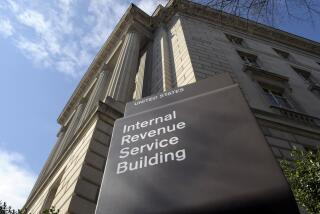Current Account Deficit Widensin 2nd Quarter
- Share via
WASHINGTON — The deficit in the broadest measure of U.S. trade widened to $30.99 billion from April through June as the country suffered its first shortfall in the category covering overseas investment earnings in three decades, the government reported Tuesday.
The Commerce Department said the current account deficit rose by 2 percent over the January-March imbalance of $30.39 billion. It marked the second consecutive quarterly setback and provided fresh evidence, economists said, of how entrenched America’s trade problems are.
The current account, also known as the balance of payments, is the most important trade statistic because it measures not only trade in merchandise but also trade in services.
The deficit in merchandise trade actually narrowed during the spring, falling by 2.3 percent to $27.7 billion, the smallest imbalance in merchandise trade in more than four years.
However, this improvement was offset by the first deficit in the services category since 1958.
That category, which primarily reflects investment earnings between countries, registered a deficit of $176 million in the second quarter, compared with a surplus of $1.5 billion in the first quarter.
Analysts called the services deficit an ominous sign as foreigners begin to earn more and more on their U.S. investments, making it even more difficult for the country to close its trade gap.
“The negative services payment is a distressing omen. We are now paying more to foreigners on their U.S. investments than we are earning on our assets in foreign countries and that is worrisome,” said Allen Sinai, chief economist for the Boston Co.
While the spring services deficit was small and could well be revised away in coming reports, analysts said the trend is clear: The United States will be forced to transfer more and more wealth overseas to service the growing level of foreign holdings in the United States.
John Hagens, senior economist at the WEFA Group, an economic consulting company, said he expected the services trade category would be in deficit throughout the 1990s, reflecting the fact that the United States is the world’s largest debtor country.
Simply put, that means foreigners own more in U.S. assets than Americans own overseas. America’s net debtor position stood at $532.5 billion at the end of last year and is expected to worsen by another $120 billion this year.
Many economists predict that U.S. living standards will begin declining because financing the growing foreign debt burden will make less funds available in this country.
“We are a half-trillion dollars in debt to the rest of the world and debtors must eventually pay the piper,” Hagens said.
In addition to merchandise and services, the third segment of the current account deficit, U.S. foreign aid payments and pensions to Americans living overseas, fell by 11.4 percent to $3.1 billion in the spring.
The current account deficit reflects the sum of the deficits in services, merchandise trade and so-called unilateral transfers.
For the first six months of the year, the current account deficit ran at an annual rate of $122.76 billion, down only slightly from the 1988 deficit of $126.55 billion.
More to Read
Inside the business of entertainment
The Wide Shot brings you news, analysis and insights on everything from streaming wars to production — and what it all means for the future.
You may occasionally receive promotional content from the Los Angeles Times.










